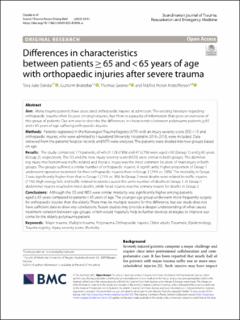| dc.contributor.author | Slørdal, Tora Julie | |
| dc.contributor.author | Brattebø, Guttorm | |
| dc.contributor.author | Geisner, Thomas | |
| dc.contributor.author | Kristoffersen, Målfrid Holen | |
| dc.date.accessioned | 2022-11-08T14:51:14Z | |
| dc.date.available | 2022-11-08T14:51:14Z | |
| dc.date.created | 2022-10-26T13:29:41Z | |
| dc.date.issued | 2022-09-24 | |
| dc.identifier.issn | 1757-7241 | |
| dc.identifier.uri | https://hdl.handle.net/11250/3030727 | |
| dc.description.abstract | Aim: Many trauma patients have associated orthopaedic injuries at admission. The existing literature regarding orthopaedic trauma often focuses on single injuries, but there is a paucity of information that gives an overview of this group of patients. Our aim was to describe the differences in characteristics between polytrauma patients ≥ 65 and < 65 years of age suffering orthopaedic injuries.
Methods: Patients registered in the Norwegian Trauma Registry (NTR) with an injury severity score (ISS) > 15 and orthopaedic injuries, who were admitted to Haukeland University Hospital in 2016–2018, were included. Data retrieved from the patients’ hospital records and NTR were analysed. The patients were divided into two groups based on age.
Results: The study comprised 175 patients, of which 128 (73%) and 47 (27%) were aged < 65 (Group 1) and ≥ 65 years (Group 2), respectively. The ISS and the new injury severity score (NISS) were similar in both groups. The dominating injury mechanism was traffic-related and thoracic injury was the most common location of main injury in both groups. The groups suffered a similar number of orthopaedic injuries. A significantly higher proportion of Group 1 underwent operative treatment for their orthopaedic injuries than in Group 2 (74% vs. 53%). The mortality in Group 2 was significantly higher than that in Group 1 (15% vs. 3%). In Group 2 most deaths were related to traffic injuries (71%). High energy falls and traffic-related incidents caused the same number of deaths in Group 1. In Group 1 abdominal injuries resulted in most deaths, while head injuries was the primary reason for deaths in Group 2.
Conclusions: Although the ISS and NISS were similar, mortality was significantly higher among patients aged ≥ 65 years compared to patients < 65 years of age. The younger age group underwent more frequently surgery for orthopaedic injuries than the elderly. There may be multiple reasons for this difference, but our study does not have sufficient data to draw any conclusions. Future studies may provide a deeper understanding of what causes treatment variation between age groups, which would hopefully help to further develop strategies to improve outcome for the elderly polytrauma patient. | en_US |
| dc.language.iso | eng | en_US |
| dc.publisher | BMC | en_US |
| dc.rights | Navngivelse 4.0 Internasjonal | * |
| dc.rights.uri | http://creativecommons.org/licenses/by/4.0/deed.no | * |
| dc.title | Differences in characteristics between patients ≥ 65 and < 65 years of age with orthopaedic injuries after severe trauma | en_US |
| dc.type | Journal article | en_US |
| dc.type | Peer reviewed | en_US |
| dc.description.version | publishedVersion | en_US |
| dc.rights.holder | Copyright 2022 the authors | en_US |
| dc.source.articlenumber | 51 | en_US |
| cristin.ispublished | true | |
| cristin.fulltext | original | |
| cristin.qualitycode | 1 | |
| dc.identifier.doi | 10.1186/s13049-022-01038-w | |
| dc.identifier.cristin | 2065258 | |
| dc.source.journal | Scandinavian Journal of Trauma, Resuscitation and Emergency Medicine | en_US |
| dc.identifier.citation | Scandinavian Journal of Trauma, Resuscitation and Emergency Medicine. 2022, 30, 51. | en_US |
| dc.source.volume | 30 | en_US |

